Bayou Plaquemine: Locks, Family Ties & A Journey Through Time
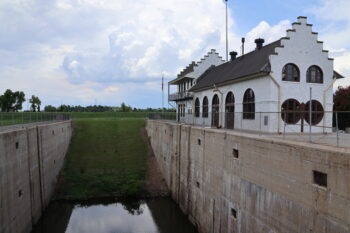
Bayou Plaquemine: Locks, Family Ties & A Journey Through Time
There are moments when a single photograph pulls the thread of a memory so vividly that it stops you mid-scroll. That’s exactly what happened when I stumbled across an article about the restoration of the Plaquemine Lock in Louisiana.
The photo featured a familiar sight: a white pump house standing proudly beside the locks. Suddenly, I was a child again, hand in hand with my father, walking the same grounds—my uncle, Houston Buras, working here as a lock operator. A childhood memory, long buried under decades of living, rose to the surface.
And just like that, a side trip was born.
🧳 Back to the Bayou: Why We Made the Trip
Our main reason for heading to Baton Rouge was the Blues Express LSR Convention 2025, Lone Star Region Convention of the National Model Railroad Association (NMRA)—my husband, Urs’s, passion project. He’s a committed HO-scale model railroader, and conferences like this are his inspiration gathering sessions. We attended lectures, hands-on clinics, and met other passionate builders.
But when Urs asked if I had any local stops I’d like to add, I didn’t hesitate:
“I want to see the Plaquemine Locks.”
🧭 Time to Explore
It was a short 25-minute drive from Baton Rouge. We crossed the Mississippi River, with views that never fail to impress, and followed Highway 1 toward Plaquemine. As we neared the site, there it was—the white lock house, just as I remembered it from 66 years ago. (Yes, I just gave away my age… but who’s counting?)
🤝 A Southern Welcome and a Serendipitous Connection
As we entered the historic site, we were greeted by Mr. Stanley Richardson, a museum guide with a warm Southern hello and a cold bottle of water.
“What brings y’all from Houston to little ol’ Plaquemine?” he asked.
I shared my story—the memory of visiting my uncle at the locks, my dad holding my hand, the white building forever imprinted in my mind. Stanley’s face lit up. He reached into his desk drawer and pulled out a photograph.
“Is this the man you’re talking about?”
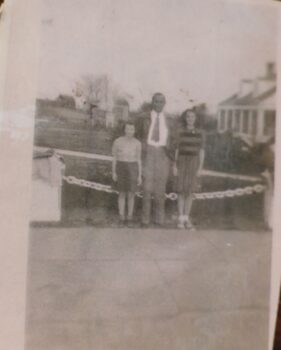
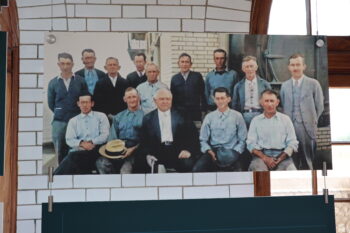
🛠️ Walking Through Engineering History
Stanley guided us through the Plaquemine Lock facility, pausing at an old group photograph of lock operators. There was Uncle Houston again, standing proudly among his coworkers. You could feel the pride and purpose in every image, every plaque, every inch of the space.
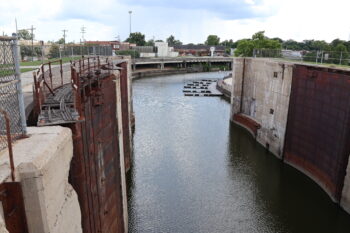
Outside, Urs and I walked along the canal, once the lifeline between the Mississippi River and Louisiana’s interior. Though the locks are now decommissioned and filled in, their structure remains remarkably intact. Without 50 feet of water, we could clearly see the massive steel gates, designed to open and close, adjusting water levels so that ships, barges, and riverboats could pass safely.
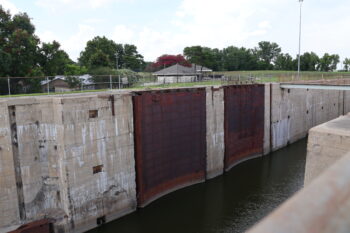
Even without their original purpose, the locks stood tall—silent yet monumental witnesses to a century of river commerce.
💭 Final Reflections
This visit was more than a historical pit stop. It was a full-circle moment—one that blended Louisiana’s river history with the memory of my family’s connection to it. Seeing Uncle Houston’s photo, hearing his name spoken with respect, and walking those grounds reminded me how much personal history is hidden inside public spaces.
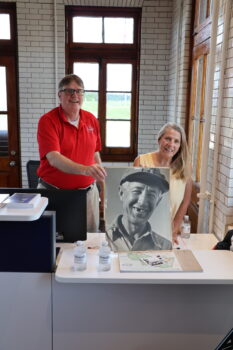
If you’re traveling through Baton Rouge, take the detour to Plaquemine. Walk the lock grounds. Listen to the stories. You may just uncover a piece of your own past, waiting quietly beside the bayou.
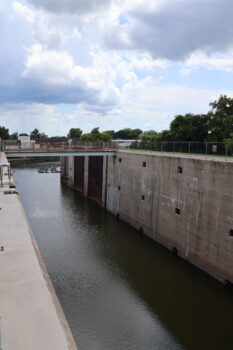 🧱 About the Plaquemine Locks
🧱 About the Plaquemine Locks
The Plaquemine Lock was completed in 1909 and was considered an engineering marvel of its time. Designed by Colonel George Goethals, who would later become chief engineer of the Panama Canal, the lock could lift boats 51 feet—a world record back then.
Goethals even chose white glazed bricks for the lock house exterior to reflect light, a clever alternative in an era with no river lighthouses.
The lock served as a gateway, allowing boats to pass from Bayou Plaquemine into the Mississippi River and vice versa. Today, it’s a Louisiana State Historic Site, carefully preserved to educate and inspire future generations12.
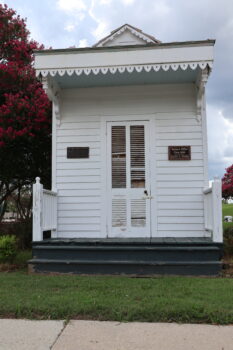
🧭 Quick Facts & Visitor Info
📍 Location:
Plaquemine Lock State Historic Site
57730 Main Street, Plaquemine, LA
🕒 Hours:
Tuesday – Saturday: 9:00 a.m. – 5:00 p.m.
📞 Info Line:
Call 225-687-7158 for admission info (currently free)
🌐 Official Website:
Plaquemine Lock State Historic Site
👨👩👧 Population of Plaquemine:
6,269 (2020 U.S. Census)3
📚 Footnotes & References
- Friends of the Lock: ↩
- LA State Parks – Plaquemine Lock Site: ↩
- U.S. Census Bureau: Plaquemine, Louisiana – Census QuickFacts ↩
🔎 Looking for more? For more articles on our Short Haul to Louisiana, be sure to click over to:
A Taste of Gratitude: Honoring the Merci Train in Cajun Country
Exploring Baton Rouge: A Step Back in Time at the Old State Capitol
🖊️ We’d love to hear from you!
Your thoughts, comments, and insights on this post—or any of our articles—are always warmly welcome. Thanks so much for stopping by Take Another Route. We’re glad you’re here, and we hope you’ll join the conversation!


